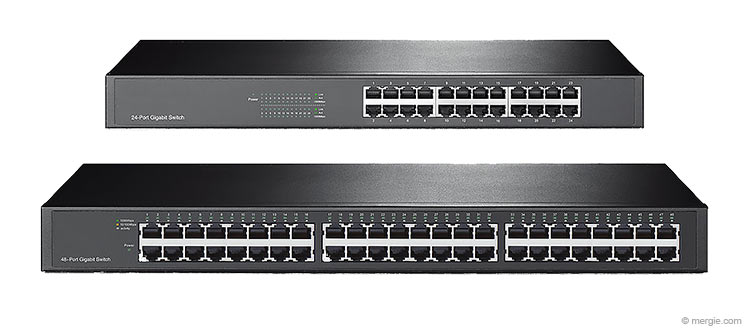Buying a Network Ethernet Switch
When you look to buy a network (ethernet) switch, there is a multitude of terms to get to grips with and different configurations available…
- Managed or Unmanaged?
- Fast Ethernet or Gigabit?
- Power Usage (Is it the Network Switch Green)?
- How Many Ports do I Need?
- One or Two Ethernet Switches?
- Does my Network Switch Have a Fan?
Managed or Unmanaged?
A managed switch means you can control the ethernet switch remotely via a web browser. This is ideal if your not on site, or managing a business network and want to set a multitude of parameters.
However, if yours is just a small local network, there may not be the need? A non-managed switch is basically a plug and play option, (without the potential headache of setting up the ethernet switch). Plus, you gain with:
- Reduced running costs (greener).
- Reduced power consumption (heat and cost).
- Longer life (the life of electronic components is shortened by heat degradation).
- They are often quieter (lower power consumption may mean there’s no need for a noisy cooling fan – See ‘Does my Network Switch Have a Fan?‘).
Fast Ethernet or Gigabit?
Fast ethernet is a 10/100 Megabit setup. Unless you’re using old equipment…
Always go for a 10/100/1000 Gigabit setup.
Beware – A lot of ethernet switches are advertised as Gigabit, but only some of the ports are Gigabit! For instance:
- 24 Port Gigabit Ethernet Switch (4 x 10/100/1000).
- 24 Port Ethernet Switch Gigabit x 4.
All the ports need to be Gigabit (Unless you’re using old equipment).
- Check and read the specifications.
- A slight change in model number can mean the unit is different in both minor, and major ways.
Power Usage – Is the Network Switch Green?
There can be a large difference in the power usage of an ethernet switch.
- An old unit can be far more power hungry than a new unit.
- A new unmanaged switch will have a low power usage.
- A managed switch will have a medium power usage.
- A POE (Power Over Ethernet – Able to run CCTV, phones, etc) switch will have a high power usage.
How Many Ports do I Need?
Count up all your equipment that has an ethernet port. Then add a bit more for expansion. For instance I started with wall sockets in each room that had two ports, and have now I have gone to four plus in each room!
- Computer.
- Laptop.
- Display/TV.
- Media Unit.
- Games console.
- Bluray player.
- Household goods, freezer, washing machine, etc.
One or Two Ethernet Switches?

Buying two switches can be far more economical than buying one.
For instance, say you want a 48 port switch. A 48 port switch may be a lot more expensive than 2 x 24 port switches.
The reason for this is… As the number of ports increases, you start to approach the business market.
- The home network range tend to have a large number of unmanaged switches (small number of ports).
- Whereas the business market has few unmanaged switches (but a large number of ports).
Power Usage:
Check the power usage of 1 x 48 port, as opposed to 2 x 24 port? Looking at a TP-Link example (TL-SG1016), 1 x 48 port used 29% less power than 2 x 24 ports. So it then comes down to the price difference between the 2 units?
Does my Network Switch Have a Fan?
Why am I bothered about whether it has a fan or not?
Ethernet switches tend to be thin so they fit in a rack. Plus the fans are side mounted as it’s the best position for airflow (when fitted in a rack). Because of this, the cooling fans are small, (but fast) and they often make a lot of noise! This is not good, if all you can hear is the fan whirring away in the background when you’re trying to work (even if it is mounted inside a cabinet).
So if you need quiet operation, you will need a network switch that doesn’t have a fan. This will be dictated by the amount of power your network switch consumes, (as more power generates more heat).
So, if you want quiet operation, an unmanaged ethernet switch may be your best bet, as it will draw less power. Check the switch specifications though, as some small managed network switches may also be fanless.
Alternative solution:
A bigger fan… A larger diameter fan tends to create less noise (it often spins slower). You can modify the network switch case to install a computer case fan (there are lots of computer case fans advertised as quiet fans). This modification does involve cutting a big hole in the top of the switch case and mounting the bigger fan externally.
You may also need to:
- Provide extra space above the network switch if mounting in a rack, to accommodate the fan and provide air flow.
- Install a fan guard to prevent fingers getting stuck in the fan.
To blow or suck (a question asked many times over thousands of years)? Depends on where you want the heat to be dissipated…